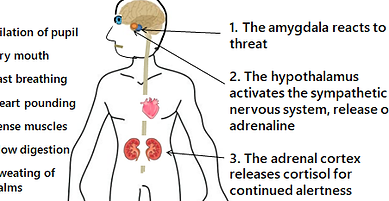Peripheral Nervous System
The peripheral nervous system consists of the nerves outside of the brain and spinal cord. Their primary function is to receive signals from the central nervous system and then use them to tell the body to move or complete resting functions, such as breathing or heartbeat. Additionally, the peripheral nervous system sends information back to the central nervous system from sensory information. To complete these functions, the system uses nerves. Nerves are bundled axons that form groups called fibres, and a couple of fibres form a nerve which reaches out to all areas of the body, helping us connect to our outside world and react.
Classification of Nerves
Nerves are classified based on what type of neurons they contain. Afferent nerves contain sensory neurons. They bring information to the brain and spinal cord, receive sensory information, and send that information to the central nervous system about the state of the organs. Efferent nerves contain motor neurons. They use information made in the central nervous system and use that to make a response, controlling the skeletal muscles for voluntary movement.

Autonomic Nervous System
The Autonomic nervous system is responsible for primarily involuntary functions. These are things such as heart function, breathing, and other reflexes such as coughing or throwing up. It is regulated by the hypothalamus

Sympathetic Nervous System
The sympathetic nervous system is a subdivision of the autonomic nervous system. It is responsible for “fight or flight”. This means the system is responsible for responding to an upcoming harmful event or when the body is in a state of stress. The response starts when the neurotransmitter noradrenaline is released, causing the blood flow to activate in the skeletal muscles and lungs. This causes things like increased heart rate, dilated pupils, and perspiration, which is the body’s way of preparing the body for self defense.

Parasympathetic Nervous System
The parasympathetic nervous system is a subdivision of the autonomic nervous system. It is responsible for “rest and digest” functions. This includes things such as heart rate, salvation, and digestion. All which help in regulating homeostasis.

Enteric Nervous System
The enteric nervous system controls the digestive moments. It is responsible for making the movements of the gastrointestinal tract, including regulating the acid of the stomach, controlling gut hormones, and interacting with the immune system. It is commonly called “the brain in the gut” because of how complicated the system is. As well as it’s high number of neurons in the area. The system also has a link to Alzheimers, which is explained in the Alzheimer’s cause page.

Somatic Nervous System
The somatic nervous system is responsible for the voluntary movements of the body. It consists of the 12 pairs of cranial nerves which send information to the brain stem or from the brainstem to the rest of the system, as well as the 31 pairs of spinal nerves that send sensory information from the peripheral nervous system to the spinal cord and the muscles.
